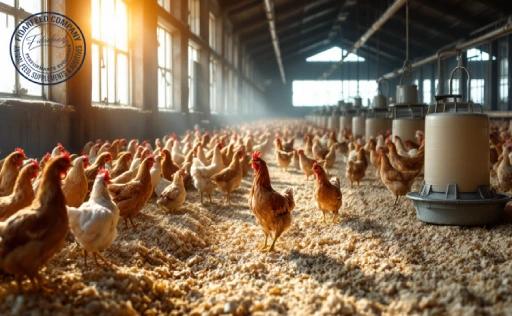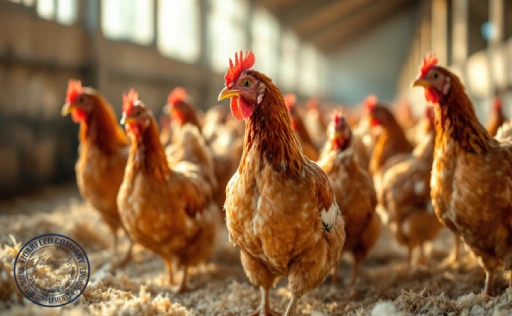
How Salmonella Gets Into Chicken is a crucial question for every chicken breeder—whether raising a backyard flock or running a large poultry farm. Salmonella is not just a food safety threat—it’s a danger to your birds, your farm’s reputation, and consumers. This comprehensive guide reveals how salmonella gets into chicken and offers actionable prevention tips to help protect your flock and your livelihood.
Understanding Poultry Infections: What Every Chicken Breeder Should Know
Salmonella is a harmful bacteria that lives in the intestines of animals and humans. Chickens infected with salmonella often show no symptoms but can still spread the bacteria through droppings. For humans, consuming contaminated meat or eggs can lead to serious illness.
Because salmonella is zoonotic—transmissible from animals to humans—it’s critical to manage its presence in chicken flocks effectively.
Learn more about: Processed Meat Meal
How Microbial Contaminants Enter Chicken Flocks: Common Access Points
Here are the most common ways salmonella gets into chickens:
- Contaminated Feed and Water
- Unsanitary Nesting and Bedding
Learn more about: Comprehensive Guide to Salmonella Management in Poultry Farms: Protecting Chickens and Humans
- Infected Hatcheries
- Equipment and Human Contact
Recognizing these sources is key to preventing how salmonella gets into chicken flocks.
Main Causes of Bacterial Contamination in Poultry Flocks
Let’s look at what makes chickens susceptible:
- Overcrowding
- Poor Hygiene
Learn more about: Smart Chicken Waste Management: Sustainable Solutions for Poultry Farmers
- Biosecurity Lapses
- Weakened Immunity
These issues directly contribute to how salmonella gets into chickens and spreads rapidly.
Disease Risks During Breeding, Hatching, and Brooding Phases
From breeding to brooding, each stage poses unique salmonella risks:
- Breeding: Parent birds may transmit salmonella to eggs.
- Hatching: Dirty incubators can infect chicks.
- Brooding: Warm, damp environments aid bacterial growth.
Learn more about: Early Signs of Marek’s Disease in Chickens: How to Detect and Act Fast
Managing these stages carefully helps prevent how salmonella gets into chicken systems early on.
Signs and Symptoms of Salmonella in Chickens: What to Watch For
Watch for these symptoms:
- Diarrhea
- Appetite loss
- Lethargy
- Drop in egg production
Learn more about: how to breed broiler chickens
Prompt detection is vital to control how salmonella gets into chicken flocks unnoticed.
How Salmonella Gets Into Backyard and Commercial Chickens
Whether you manage a small coop or industrial facility:
- Backyard Flocks: Clean coops, prevent rodent access, wash hands.
- Commercial Flocks: Enforce biosecurity, test regularly, sanitize thoroughly.
Both settings require vigilance to avoid how salmonella gets into chickens.
Effective Biosecurity to Prevent Salmonella in Chickens
Best practices include:
- Restricting visitor access
- Using footbaths
Learn more about: how to prevent marek’s disease in chickens
- Disinfecting tools
- Isolating new or sick birds
These steps are crucial to reducing how salmonella gets into chicken environments.
Feed, Water, Bedding: Hidden Pathways for Salmonella
Unclean feed and bedding directly support how salmonella gets into chicken housing:
- Feed: Store properly in sealed bins.
- Water: Clean drinkers and refresh daily.
- Bedding: Replace regularly and keep dry.
Learn more about: The Chicken Egg Production Cycle: A Comprehensive Overview
Healthy inputs block salmonella at its source.
Biosecurity Best Practices to Prevent Poultry Disease Outbreaks
Keep salmonella out by:
- Power washing and disinfecting coops
- Removing spilled feed
- Trapping or blocking rodents
Learn more about: Decreased Egg Production in Laying Hens: Common Diseases in Chickens to Watch
Rodents are a major reason how salmonella gets into chicken flocks—stop them before they start.
When to Call the Vet: Handling Serious Poultry Infections
Seek expert help if:
- Multiple birds show signs
- Treatments fail
- You need lab confirmation
- Valuable breeders are at risk
Veterinary advice limits losses and confirms how salmonella gets into chicken systems.
Long-Term Strategies for Reducing Poultry Health Risks
Secure your future by:
- Vaccinating key bird groups
- Training staff on hygiene
Learn more about: Boost Your Egg Production with Classica Layer Chickens
- Testing flocks regularly
- Designing logical farm layouts
Proactive planning helps avoid future salmonella outbreaks.
Final Thoughts: Protecting Your Chickens—and Your Reputation—from Salmonella
Every breeder should understand the many ways Salmonella can infiltrate a flock. Stay informed, maintain proper hygiene, and enforce strong biosecurity practices to keep your birds—and your business—safe. By recognizing the signs early and taking action to prevent contamination, you can significantly reduce health risks, safeguard poultry welfare, and uphold your farm’s reputation.
Whether you’re managing a small backyard coop or a large commercial operation, being proactive is key. Protecting your flock from this bacterial threat isn’t just about reacting to outbreaks—it’s about building daily routines that prevent them from occurring in the first place.
We’d love to hear from you—share your experiences, ask questions, or leave tips in the comments below. Let’s keep our flocks healthy, together!








